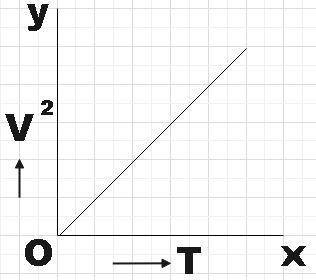
Answer
441.3k+ views
Hint: We know that in order to find the correct plot showing the variation of ${{V}^{2}}$with temperature, we should know how they are related to each other. You could either recall such a relation directly or you could derive it from some known relation and doing necessary substitutions. From the relation so found, you could easily answer the question.
Formula used:
Speed of sound,
${{V}_{s}}=\sqrt{\dfrac{\gamma RT}{M}}$
Complete Step by step solution:
In the question, we are asked to find which among the given options correctly represents the variation of the square of the speed of sound with absolute temperature. In order for us to answer this question, we should firstly find out the relation between these two quantities.
You may recall that the velocity of sound is given by,
${{V}_{s}}=\sqrt{\dfrac{\gamma P}{\rho }}$ ……………………………………………… (1)
Where,$\gamma $ is the adiabatic index, P is the pressure of the gas and $\rho $ is the density.
But we need to find a relation in terms of the absolute temperature of the gas. For that, we could recall ideal gas equation given by,
$PV=nRT$
$\Rightarrow P=\dfrac{RT}{V}=\dfrac{RT}{\dfrac{M}{\rho }}$
$\therefore \rho =\dfrac{PM}{RT}$ ……………………………………………….. (2)
Substituting (2) in (1), we get,
${{V}_{s}}=\sqrt{\dfrac{\gamma RT}{M}}$ ……………………………………………. (3)
Where, M is the molar mass of the gas, R is the universal gas constant and T is the absolute temperature.
Squaring equation (3) on both sides we get,
${{V}_{s}}^{2}=\dfrac{\gamma R}{M}T$
But we know that $\gamma $ and M for a particular gas would be constant and R is a universal constant, so,
${{V}_{s}}^{2}=kT$ ………………………………………………….. (4)
Where, k is a constant.
Now, you may recall that equation of a straight line is given by,
$y=mx+c$
Comparing with (4) we see that,
$y={{V}_{s}}^{2}$
$m=k$
$x=T$
$c=0$
So, we could conclude that equation (4) represents a straight line with intercept zero (passes through origin) and as $k=\dfrac{\gamma R}{M}$ is the slope here it would be a positive slope. Therefore, we found that, the variation of square of the speed of sound $\left( {{V}^{2}} \right)$ and absolute temperature of a gas $\left( T \right)$ is shown correctly by,

Hence, option A is found to be the correct answer.
Note:
We could define the speed of sound as the distance travelled by a sound wave per unit time. This speed has negligible dependence on frequency and pressure in ordinary air thus slightly deviating from the ideal behavior. In the case of ideal gas as the medium of propagation, the speed only depends on composition and temperature.
Formula used:
Speed of sound,
${{V}_{s}}=\sqrt{\dfrac{\gamma RT}{M}}$
Complete Step by step solution:
In the question, we are asked to find which among the given options correctly represents the variation of the square of the speed of sound with absolute temperature. In order for us to answer this question, we should firstly find out the relation between these two quantities.
You may recall that the velocity of sound is given by,
${{V}_{s}}=\sqrt{\dfrac{\gamma P}{\rho }}$ ……………………………………………… (1)
Where,$\gamma $ is the adiabatic index, P is the pressure of the gas and $\rho $ is the density.
But we need to find a relation in terms of the absolute temperature of the gas. For that, we could recall ideal gas equation given by,
$PV=nRT$
$\Rightarrow P=\dfrac{RT}{V}=\dfrac{RT}{\dfrac{M}{\rho }}$
$\therefore \rho =\dfrac{PM}{RT}$ ……………………………………………….. (2)
Substituting (2) in (1), we get,
${{V}_{s}}=\sqrt{\dfrac{\gamma RT}{M}}$ ……………………………………………. (3)
Where, M is the molar mass of the gas, R is the universal gas constant and T is the absolute temperature.
Squaring equation (3) on both sides we get,
${{V}_{s}}^{2}=\dfrac{\gamma R}{M}T$
But we know that $\gamma $ and M for a particular gas would be constant and R is a universal constant, so,
${{V}_{s}}^{2}=kT$ ………………………………………………….. (4)
Where, k is a constant.
Now, you may recall that equation of a straight line is given by,
$y=mx+c$
Comparing with (4) we see that,
$y={{V}_{s}}^{2}$
$m=k$
$x=T$
$c=0$
So, we could conclude that equation (4) represents a straight line with intercept zero (passes through origin) and as $k=\dfrac{\gamma R}{M}$ is the slope here it would be a positive slope. Therefore, we found that, the variation of square of the speed of sound $\left( {{V}^{2}} \right)$ and absolute temperature of a gas $\left( T \right)$ is shown correctly by,

Hence, option A is found to be the correct answer.
Note:
We could define the speed of sound as the distance travelled by a sound wave per unit time. This speed has negligible dependence on frequency and pressure in ordinary air thus slightly deviating from the ideal behavior. In the case of ideal gas as the medium of propagation, the speed only depends on composition and temperature.
Recently Updated Pages
10 Examples of Evaporation in Daily Life with Explanations

10 Examples of Diffusion in Everyday Life

1 g of dry green algae absorb 47 times 10 3 moles of class 11 chemistry CBSE

What is the meaning of celestial class 10 social science CBSE

What causes groundwater depletion How can it be re class 10 chemistry CBSE

Under which different types can the following changes class 10 physics CBSE

Trending doubts
Fill the blanks with the suitable prepositions 1 The class 9 english CBSE

Which are the Top 10 Largest Countries of the World?

How do you graph the function fx 4x class 9 maths CBSE

Differentiate between homogeneous and heterogeneous class 12 chemistry CBSE

Difference between Prokaryotic cell and Eukaryotic class 11 biology CBSE

Change the following sentences into negative and interrogative class 10 english CBSE

The Equation xxx + 2 is Satisfied when x is Equal to Class 10 Maths

In the tincture of iodine which is solute and solv class 11 chemistry CBSE

Why is there a time difference of about 5 hours between class 10 social science CBSE








